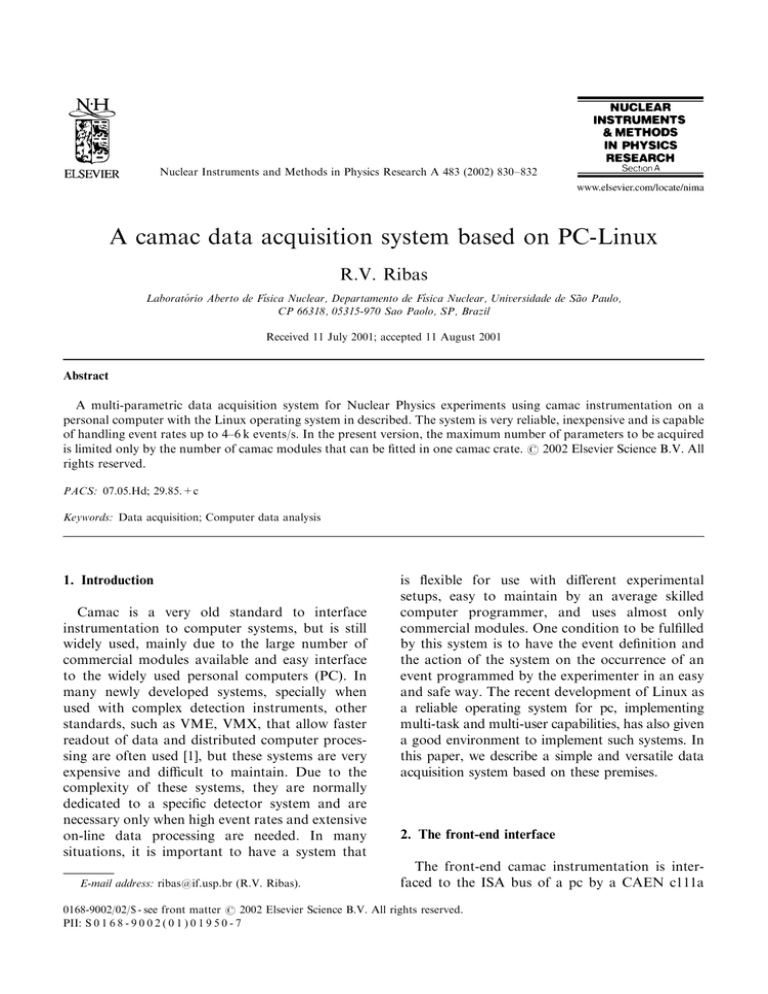
Nuclear Instruments and Methods in Physics Research A 483 (2002) 830–832
A camac data acquisition system based on PC-Linux
R.V. Ribas
!
Laboratorio
Aberto de F!ısica Nuclear, Departamento de F!ısica Nuclear, Universidade de Sao
* Paulo,
CP 66318, 05315-970 Sao Paolo, SP, Brazil
Received 11 July 2001; accepted 11 August 2001
Abstract
A multi-parametric data acquisition system for Nuclear Physics experiments using camac instrumentation on a
personal computer with the Linux operating system in described. The system is very reliable, inexpensive and is capable
of handling event rates up to 4–6 k events/s. In the present version, the maximum number of parameters to be acquired
is limited only by the number of camac modules that can be fitted in one camac crate. r 2002 Elsevier Science B.V. All
rights reserved.
PACS: 07.05.Hd; 29.85.+c
Keywords: Data acquisition; Computer data analysis
1. Introduction
Camac is a very old standard to interface
instrumentation to computer systems, but is still
widely used, mainly due to the large number of
commercial modules available and easy interface
to the widely used personal computers (PC). In
many newly developed systems, specially when
used with complex detection instruments, other
standards, such as VME, VMX, that allow faster
readout of data and distributed computer processing are often used [1], but these systems are very
expensive and difficult to maintain. Due to the
complexity of these systems, they are normally
dedicated to a specific detector system and are
necessary only when high event rates and extensive
on-line data processing are needed. In many
situations, it is important to have a system that
E-mail address: ribas@if.usp.br (R.V. Ribas).
is flexible for use with different experimental
setups, easy to maintain by an average skilled
computer programmer, and uses almost only
commercial modules. One condition to be fulfilled
by this system is to have the event definition and
the action of the system on the occurrence of an
event programmed by the experimenter in an easy
and safe way. The recent development of Linux as
a reliable operating system for pc, implementing
multi-task and multi-user capabilities, has also given
a good environment to implement such systems. In
this paper, we describe a simple and versatile data
acquisition system based on these premises.
2. The front-end interface
The front-end camac instrumentation is interfaced to the ISA bus of a pc by a CAEN c111a
0168-9002/02/$ - see front matter r 2002 Elsevier Science B.V. All rights reserved.
PII: S 0 1 6 8 - 9 0 0 2 ( 0 1 ) 0 1 9 5 0 - 7
R.V. Ribas / Nuclear Instruments and Methods in Physics Research A 483 (2002) 830–832
camac controller and the A151-A turbo board.
The main characteristic of this controller and its
interface to the pc, is that they allow very fast data
transfer to the computer using only two 16-bit ioport operations. The device driver we developed
can be easily ported to other controllers and
interfaces. We have also developed one for the
DSP-6002 controller, that is very efficient, even if
his controller has an 8-bit interface, needing about
5 io-port operations to perform one 16-bit NAF
read. This driver also includes a set of instructions
programmed by the user, to be executed in a loop
at each event reported by the camac modules. In
the present version, only one type of event can
trigger the system, using camac LAM signals. A
camac module that receives at least one parameter
that is mandatory in all events is programmed to
send LAMs to interrupt the computer. It is very
desirable that the multi-input modules used
implement a pattern word that can be used by
the driver program to read sparse data in the
module, skipping non-triggered channels. This
pattern is present in many ADCs and TDCs used
in Nuclear Physics experiments, like the Silena
4418 series and the Phillips 7164 and 7186. This
method of recognizing events is probably the main
limitation of this system. A very simple event
trigger module could be developed to handle more
complicated trigger situations. As our previous
data acquisition system was based on the Oak
Ridge Event-Handler module [2,3], we have
implemented in the driver for our c111a crate
controller, an emulator for the set of machine
instructions used in that processor. Only a few
modifications to the compiler called ADAC [4],
that is used to produce the executable code to the
original EH module, have to be made in order to
implement it to the new situation. As the actual
use of this language in the pc processor permits
much more flexibility, new instructions could be
easily implemented in the compiler. This solution
is very handy, since it allows the flexibility
necessary for a general-purpose data acquisition
system and maintains the same functionality of the
programs developed for the EH by the experimenters at our laboratory. With this police, a more
specific driver (or compiler) could also be developed to attend to specific applications. At the
831
occurrence of an interrupt, the event processor
program is executed and the event parameters are
read and formated and then placed in a fifo buffer.
The user program can asynchronally call the
driver and check for full data buffers in the fifo
and read it.
3. Acquisition and on-line monitoring modules
The basic software for the system is composed
of several independent processes that communicate to the master or manager process, and also to
the other modules, receiving and sending messages
and data. The standard Linux interprocess communication, synchronization and data exchange
resources, like messages, semaphores and shared
memory are employed. Since many parts of the
modules used in this system originates from
programs written for the VAX-VMS operating
system, almost all code was written in fortran, and
the Portland Group pgf77 fortran compiler for
Linux [5], that includes most of the DEC extensions to the fortran-77, was employed. The
routines dealing with the specifics of the operating
system were written using the standard c-compiler
available on Linux. The master process receives
commands from the user and sends it to the
process to which it is directed. The process that
communicates with the front-end camac and to the
driver, can load the EH emulator instructions list
to the driver, start and stop the acquisition runs,
accumulate the events into an event buffer and
send the event buffers to the process that will sort
the events into 1D or 2D spectra and also to mass
storage media. The event lists can be recorded
both in hard disks or magnetic tapes. Events are
processed by the sorting program in an as-muchas-I-can basis. For this procedure to be efficient,
the event buffers are stacked into a software-fifo in
the sorting program. If the even-buffer fifo is full,
the next incoming buffer is discarded. The frontend process also records statistics about the data
acquisition run, like the total number of events
acquired, time of acquisition, percentage of tape
used, etc. For the same user command, the sorting
program will also report the number of sorted
events and the number of bad events not
832
R.V. Ribas / Nuclear Instruments and Methods in Physics Research A 483 (2002) 830–832
recognized by that program. Pre-set time can also
be enabled for the runs and a bipper can warn the
experimenters if event buffers do not come within
a minimum pre-defined time interval. In the
present version, the sorting program can produce
up to 16 Mbytes of 1D and 2D histograms in ram
memory, with 16 or 32 bits for each channel. This
module is what is called a CHIL-processor, since it
interprets CHIL-language instructions. Comprehensive HIstograming Language (CHIL) is a
compiler developed by WT Milner [4], that is used
in many on-line and off-line histograming programs. The core memory histograms are shared
with the display, analysis and manipulation
program named DAMM, also written by Milner
[4]. DAMM processes are not linked to the rest of
the system, and any number of DAMM processes
can have access to the on-line histograms. On-line
histograms can also be stored on disk at any time
for posterior analysis.
4. Benchmarks
All tests were done using a P-133 cpu running
the Conectiva Linux Distribution [6]. In a typical
event occurring in our system about 4–10 parameters are read out of a much larger number of
defined ones. Typical converting times of camac
ADCs and TDCs range from 5 to 100 ms. The
driver takes about 15 ms from the time the LAM
was posted, in order to start transferring data from
the crate. If the LAM can be generated before the
end of conversion of the ADCs, the converting
time can be superposed to this overhead time.
With the CAEN turbo interface, about 4 ms is
spent for each 16-bit read operation. With a
moderate event rate (2–3 k events/s), and typical
sorting requests, the fraction of computer time
spent by the sorting program or by the display
program almost does not affect the throughput of
events to the computer.
5. Conclusions and planned improvements
The system is starting to be used on a regular
basis as a secondary data acquisition system in
our laboratory. It is very stable, even in high
event rates and complex histograming conditions. The driver developed can handle only one
crate controller, but there should be no major
difficulties to port it to be used with more
controllers, since the CAEN A151A can interface up to 16 crate controllers. With typical event
rates (2–3 k/s) all acquired events were histogramed by the CHIL processor. Similar systems
using the DSP-6002 crate controller are also
being used, with quite good performance, despite
their 8-bit interface. We are also planning to
build an event trigger module that will be able
to send LAMs to the computer previous to
the conversion completion by the modules and
that will also be able to generate a pattern bit
word classifying different types of events. This
module will also generate a veto NIM signal
for the duration of time from the event trigger to
the end of the event transfer by the computer,
which can be used to measure the dead time
of the system. This system could also be adapted to
be used with other histograming and event
processing languages like NEO [7]. The use with
a set of modules that incorporates the FERA bus
to the camac can also be foreseen. As a complement to this system, we have also ported to the
Linux operating system, many programs from
Upak [4], for off-line analysis of the data
produced. Source and executable codes for all
these programs can be obtained by contacting the
author, ribas@if.usp.br.
References
[1] C. Rossi-Alvarez, Nuovo Cimento 111A (1998) 601.
[2] D.C. Hensley, IEEE Trans. Nucl. Sci. NS-26 (1979)
4454.
[3] R.V. Ribas, Annual Report, Nuclear Physics Department,
University of S*ao Paulo, 1996, p. 64.
[4] W.T. Milner, Upak documentation, Oak Ridge National
Laboratory.
[5] Portland Group, www.pgroup.com.
[6] Conectiva Linux, www.conectiva.com.br.
[7] B. D’Avanzo, M. De Poli, G. Maron, A. Negro, G. Parlati,
D. Pascoli, R.V. Ribas, S. Scanferlato, G. Vedovato,
Proceedings of the Real Time’91 Conference, Jülich,
Germany, 1991.




